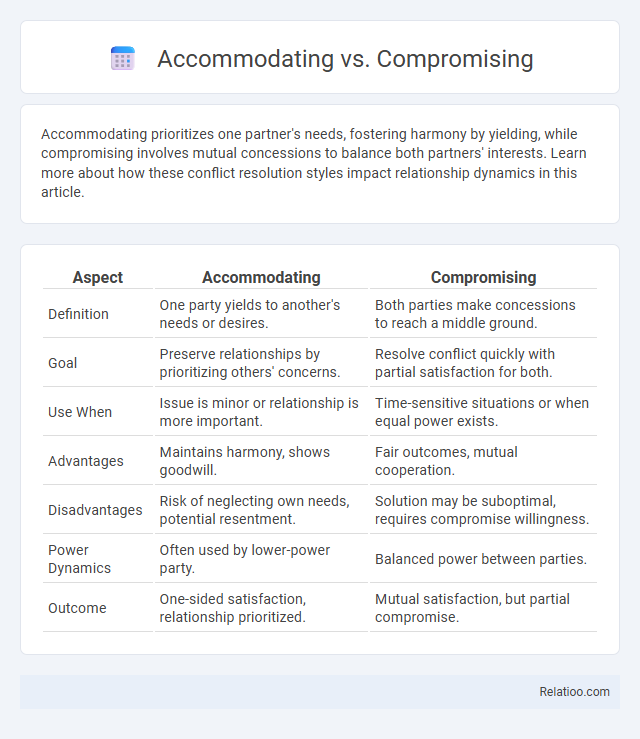Accommodating prioritizes one partner's needs, fostering harmony by yielding, while compromising involves mutual concessions to balance both partners' interests. Learn more about how these conflict resolution styles impact relationship dynamics in this article.
Table of Comparison
| Aspect | Accommodating | Compromising |
|---|---|---|
| Definition | One party yields to another's needs or desires. | Both parties make concessions to reach a middle ground. |
| Goal | Preserve relationships by prioritizing others' concerns. | Resolve conflict quickly with partial satisfaction for both. |
| Use When | Issue is minor or relationship is more important. | Time-sensitive situations or when equal power exists. |
| Advantages | Maintains harmony, shows goodwill. | Fair outcomes, mutual cooperation. |
| Disadvantages | Risk of neglecting own needs, potential resentment. | Solution may be suboptimal, requires compromise willingness. |
| Power Dynamics | Often used by lower-power party. | Balanced power between parties. |
| Outcome | One-sided satisfaction, relationship prioritized. | Mutual satisfaction, but partial compromise. |
Understanding Accommodating and Compromising
Accommodating involves yielding to others' needs and preferences to maintain harmony, often prioritizing relationships over personal goals. Compromising seeks a middle ground where all parties give up something, balancing assertiveness and cooperation to reach a mutually acceptable solution. Understanding these conflict styles enhances communication by recognizing when to prioritize collaboration or concession for effective resolution.
Key Differences Between Accommodating and Compromising
Accommodating prioritizes others' needs over your own, aiming to maintain harmony by yielding completely, while compromising involves mutual concession where both parties give up something to reach a middle ground. Responsiveness measures how quickly and effectively someone reacts to others' requests, influencing the choice between accommodating or compromising strategies in conflict resolution. Understanding these distinctions helps optimize your approach to negotiation, ensuring balanced outcomes without sacrificing core interests.
Situations Best Suited for Accommodating
Accommodating is best suited for situations where preserving relationships is more important than winning an argument, especially when Your counterpart values harmony or when the issue is minor to You. It works well when one party realizes they were wrong or when the stakes are low, allowing quick conflict resolution and goodwill maintenance. In cases of emotional tension or when the opposing party holds more power, accommodating demonstrates empathy and fosters future collaboration.
When to Choose Compromising in Conflict Resolution
Choose compromising in conflict resolution when both parties seek a quick, mutually acceptable solution that balances competing interests without requiring full satisfaction. This approach works well in situations with moderate urgency, limited resources, or when maintaining relationships is important but not critical. Compromising is ideal when neither party's position is overwhelmingly dominant and both are willing to give up some demands to reach an efficient agreement.
Advantages of the Accommodating Approach
The accommodating approach fosters harmony by prioritizing the needs and concerns of others, making it ideal for resolving conflicts where preserving relationships is crucial. Your willingness to yield can build trust and goodwill, often leading to quicker, less contentious resolutions. This method enhances collaboration and maintains a positive team dynamic by showing empathy and respect for different perspectives.
Benefits of Compromising in Negotiations
Compromising in negotiations allows both parties to achieve a mutually acceptable solution by balancing interests and making concessions, which fosters cooperation and maintains relationships. You benefit from quicker conflict resolution and reduced tension, creating a foundation for future collaboration. This approach ensures that neither side feels completely defeated, enhancing trust and long-term partnership potential.
Potential Drawbacks of Accommodating
Accommodating prioritizes others' needs over your own, which can lead to unresolved personal issues and feelings of resentment. This style may create imbalances in relationships, reducing your influence and potentially encouraging others to exploit your willingness to yield. Overuse of accommodating can undermine effective conflict resolution by neglecting your own interests and diminishing mutual satisfaction.
Limitations of the Compromising Method
The compromising method often leads to solutions where neither party fully achieves their goals, limiting long-term satisfaction and potentially causing recurring conflicts. Your ability to find durable agreements may be compromised because this approach emphasizes middle-ground settlements rather than addressing underlying concerns. Responsiveness and accommodating styles tend to foster more collaborative and flexible problem-solving compared to the rigid nature of compromising.
Practical Examples: Accommodating vs Compromising
Accommodating involves yielding to others' needs to maintain harmony, such as a manager allowing an employee's request for flexible hours to support work-life balance. Compromising requires mutual concessions, like two team members agreeing to split project duties when both want more involvement. Responsiveness is demonstrated by adapting communication styles or actions promptly to meet colleagues' changing preferences or concerns during collaboration.
How to Decide: Accommodating or Compromising?
Deciding between accommodating and compromising depends on the priority of relationships versus outcomes; accommodating prioritizes maintaining harmony by yielding to others' needs, ideal when preserving goodwill is crucial. Compromising seeks a middle ground where both parties give up something, best suited for situations requiring quick solutions with moderate satisfaction. Evaluate the importance of the issue, time constraints, and long-term relationship goals to choose the appropriate conflict resolution style.

Infographic: Accommodating vs Compromising
 relatioo.com
relatioo.com